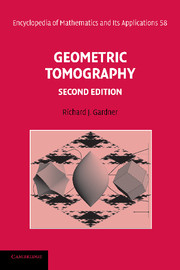Book contents
- Frontmatter
- Contents
- Preface to the second edition
- Preface
- 0 Background material
- 1 Parallel X-rays of planar convex bodies
- 2 Parallel X-rays in n dimensions
- 3 Projections and projection functions
- 4 Projection bodies and volume inequalities
- 5 Point X-rays
- 6 Chord functions and equichordal problems
- 7 Sections, section functions, and point X-rays
- 8 Intersection bodies and volume inequalities
- 9 Estimates from projection and section functions
- Appendixes
- References
- Notation
- Author index
- Subject index
Preface
Published online by Cambridge University Press: 05 June 2013
- Frontmatter
- Contents
- Preface to the second edition
- Preface
- 0 Background material
- 1 Parallel X-rays of planar convex bodies
- 2 Parallel X-rays in n dimensions
- 3 Projections and projection functions
- 4 Projection bodies and volume inequalities
- 5 Point X-rays
- 6 Chord functions and equichordal problems
- 7 Sections, section functions, and point X-rays
- 8 Intersection bodies and volume inequalities
- 9 Estimates from projection and section functions
- Appendixes
- References
- Notation
- Author index
- Subject index
Summary
The title of this book, Geometric Tomography, is designed to cover the area of mathematics dealing with the retrieval of information about a geometric object from data about its sections, or projections, or both. The term “geometric object” is deliberately vague; a convex polytope or body would certainly qualify, as would a star-shaped body, or even, when appropriate, a compact set or measurable set.
The word “tomography” originates from the Greek τόμος, meaning a slice. Mathematical computerized tomography is already a recognized subject with an enormously important application in the medical CAT scanner, with which an image of a section of a human patient can be reconstructed from X-rays. Mathematically, the object being reconstructed is a density function, and since it is known that the solution is not unique, no matter how (finitely) many X-rays are taken, the reconstructed picture is always an approximation. When density functions are replaced by geometric objects, there is some hope of a unique solution, and this gives geometric tomography a rather different flavor.
Despite this, there is a point where geometric tomography and computerized tomography merge, and both utilize integral transforms such as the Radon transform. Our definition of geometric tomography is also reminiscent of definitions of stereology or geometric probing. These subjects each have their own distinct viewpoint, while sharing common features with geometric tomography. For example, stereology focuses on random data and statistical methods, but also draws on integral geometry (as do two other related subjects, image analysis and mathematical morphology).
- Type
- Chapter
- Information
- Geometric Tomography , pp. xvii - xxiiPublisher: Cambridge University PressPrint publication year: 2006

